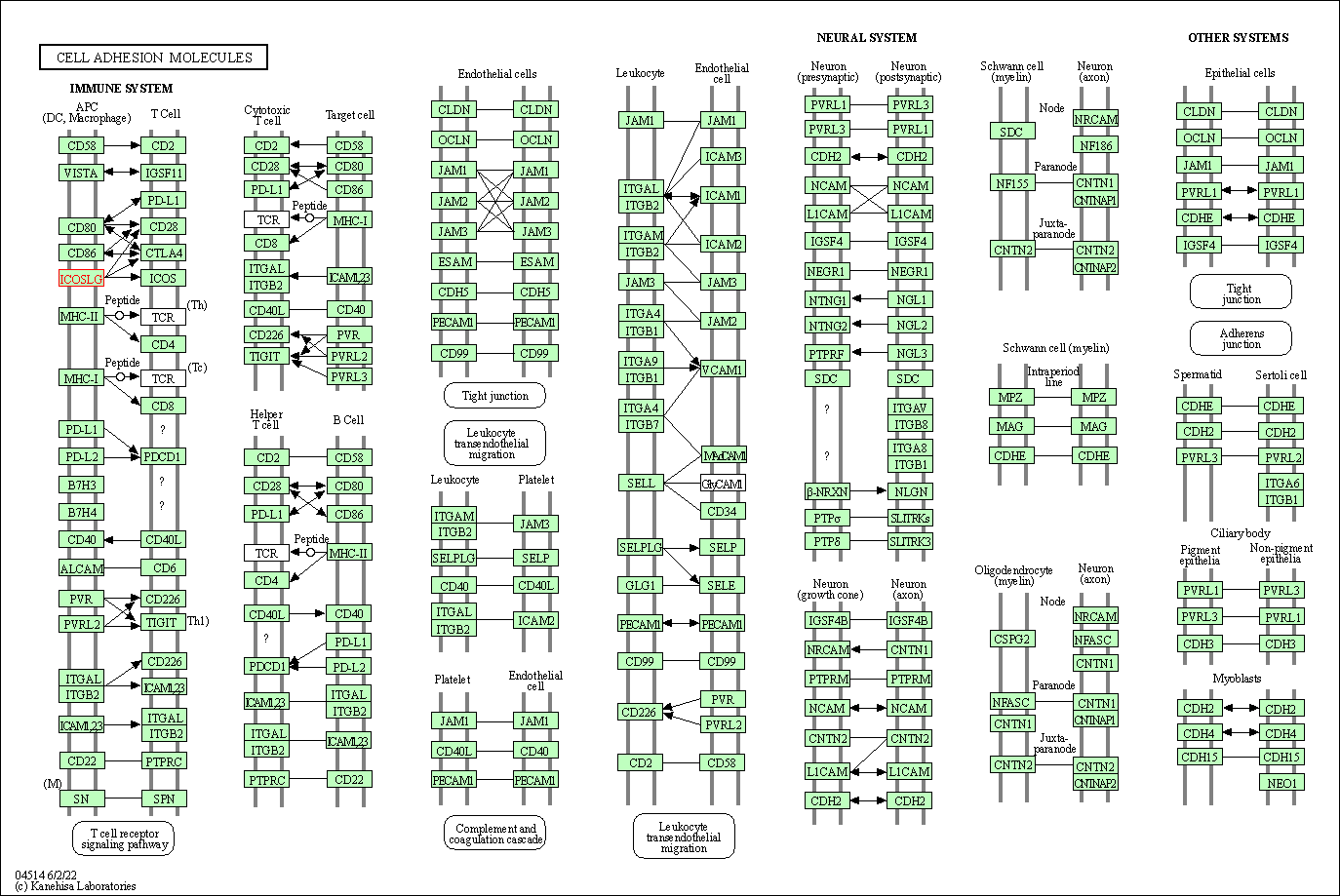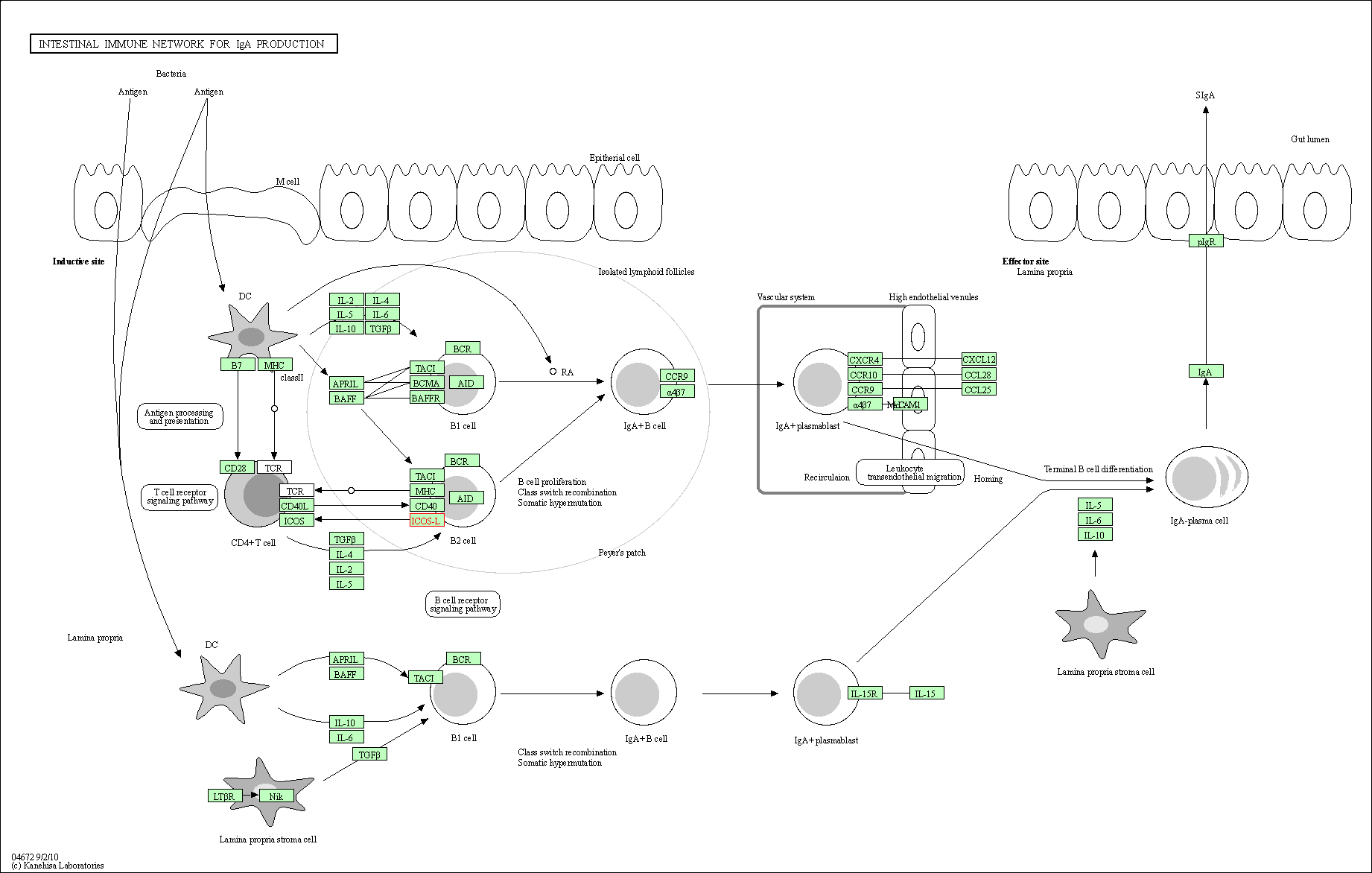Target Information
| Target General Information | Top | |||||
|---|---|---|---|---|---|---|
| Target ID |
T16144
(Former ID: TTDNC00463)
|
|||||
| Target Name |
B7-related protein 1 (B7RP1)
|
|||||
| Synonyms |
KIAA0653; ICOSL; ICOS ligand; CD275; B7related protein 1; B7like protein Gl50; B7RP-1; B7H2; B7-like protein Gl50; B7-H2; B7 homolog 2
Click to Show/Hide
|
|||||
| Gene Name |
ICOSLG
|
|||||
| Target Type |
Clinical trial target
|
[1] | ||||
| Disease | [+] 2 Target-related Diseases | + | ||||
| 1 | Lupus erythematosus [ICD-11: 4A40] | |||||
| 2 | Sjogren syndrome [ICD-11: 4A43] | |||||
| Function |
Acts as a costimulatory signal for T-cell proliferation and cytokine secretion; induces also B-cell proliferation and differentiation into plasma cells. Could play an important role in mediating local tissue responses to inflammatory conditions, as well as in modulating the secondary immune response by co-stimulating memory T-cell function. Ligand for the T-cell-specific cell surface receptor ICOS.
Click to Show/Hide
|
|||||
| BioChemical Class |
Immunoglobulin
|
|||||
| UniProt ID | ||||||
| Sequence |
MRLGSPGLLFLLFSSLRADTQEKEVRAMVGSDVELSCACPEGSRFDLNDVYVYWQTSESK
TVVTYHIPQNSSLENVDSRYRNRALMSPAGMLRGDFSLRLFNVTPQDEQKFHCLVLSQSL GFQEVLSVEVTLHVAANFSVPVVSAPHSPSQDELTFTCTSINGYPRPNVYWINKTDNSLL DQALQNDTVFLNMRGLYDVVSVLRIARTPSVNIGCCIENVLLQQNLTVGSQTGNDIGERD KITENPVSTGEKNAATWSILAVLCLLVVVAVAIGWVCRDRCLQHSYAGAWAVSPETELTG HV Click to Show/Hide
|
|||||
| 3D Structure | Click to Show 3D Structure of This Target | AlphaFold | ||||
| Cell-based Target Expression Variations | Top | |||||
|---|---|---|---|---|---|---|
| Cell-based Target Expression Variations | ||||||
| Different Human System Profiles of Target | Top |
|---|---|
|
Human Similarity Proteins
of target is determined by comparing the sequence similarity of all human proteins with the target based on BLAST. The similarity proteins for a target are defined as the proteins with E-value < 0.005 and outside the protein families of the target.
A target that has fewer human similarity proteins outside its family is commonly regarded to possess a greater capacity to avoid undesired interactions and thus increase the possibility of finding successful drugs
(Brief Bioinform, 21: 649-662, 2020).
Human Tissue Distribution
of target is determined from a proteomics study that quantified more than 12,000 genes across 32 normal human tissues. Tissue Specificity (TS) score was used to define the enrichment of target across tissues.
The distribution of targets among different tissues or organs need to be taken into consideration when assessing the target druggability, as it is generally accepted that the wider the target distribution, the greater the concern over potential adverse effects
(Nat Rev Drug Discov, 20: 64-81, 2021).
Human Pathway Affiliation
of target is determined by the life-essential pathways provided on KEGG database. The target-affiliated pathways were defined based on the following two criteria (a) the pathways of the studied target should be life-essential for both healthy individuals and patients, and (b) the studied target should occupy an upstream position in the pathways and therefore had the ability to regulate biological function.
Targets involved in a fewer pathways have greater likelihood to be successfully developed, while those associated with more human pathways increase the chance of undesirable interferences with other human processes
(Pharmacol Rev, 58: 259-279, 2006).
Human Similarity Proteins
Human Tissue Distribution
Human Pathway Affiliation
|
|
|
Note:
If a protein has TS (tissue specficity) scores at least in one tissue >= 2.5, this protein is called tissue-enriched (including tissue-enriched-but-not-specific and tissue-specific). In the plots, the vertical lines are at thresholds 2.5 and 4.
|
| KEGG Pathway | Pathway ID | Affiliated Target | Pathway Map |
|---|---|---|---|
| Cell adhesion molecules | hsa04514 | Affiliated Target |

|
| Class: Environmental Information Processing => Signaling molecules and interaction | Pathway Hierarchy | ||
| Intestinal immune network for IgA production | hsa04672 | Affiliated Target |

|
| Class: Organismal Systems => Immune system | Pathway Hierarchy | ||
| Target Regulators | Top | |||||
|---|---|---|---|---|---|---|
| Target-regulating microRNAs | ||||||
| Target Affiliated Biological Pathways | Top | |||||
|---|---|---|---|---|---|---|
| KEGG Pathway | [+] 2 KEGG Pathways | + | ||||
| 1 | Cell adhesion molecules (CAMs) | |||||
| 2 | Intestinal immune network for IgA production | |||||
| Reactome | [+] 1 Reactome Pathways | + | ||||
| 1 | Costimulation by the CD28 family | |||||
| WikiPathways | [+] 1 WikiPathways | + | ||||
| 1 | Costimulation by the CD28 family | |||||
| References | Top | |||||
|---|---|---|---|---|---|---|
| REF 1 | Administration Of AMG 557, A Human Anti-B7RP-1 (ICOSL) Antibody, Leads To The Selective Inhibition Of Anti-KLH IgG Responses In Subjects With SLE: Results Of A Phase 1 Randomized, Double-Blind, Placebo-Controlled, Sequential, Rising, Multiple-Dose Study. San Diego, CA October 25-30, 2013 | |||||
| REF 2 | ClinicalTrials.gov (NCT02334306) A Phase 2a, Randomized, Placebo Controlled, Study to Evaluate the Safety and Efficacy of AMG 557/MEDI5872 in Primary Sj ren's Syndrome. U.S. National Institutes of Health. | |||||
| REF 3 | ClinicalTrials.gov (NCT04058028) Efficacy and Safety of AMG 570 in Subjects With Active Systemic Lupus Erythematosus (SLE). U.S. National Institutes of Health. | |||||
If You Find Any Error in Data or Bug in Web Service, Please Kindly Report It to Dr. Zhou and Dr. Zhang.

